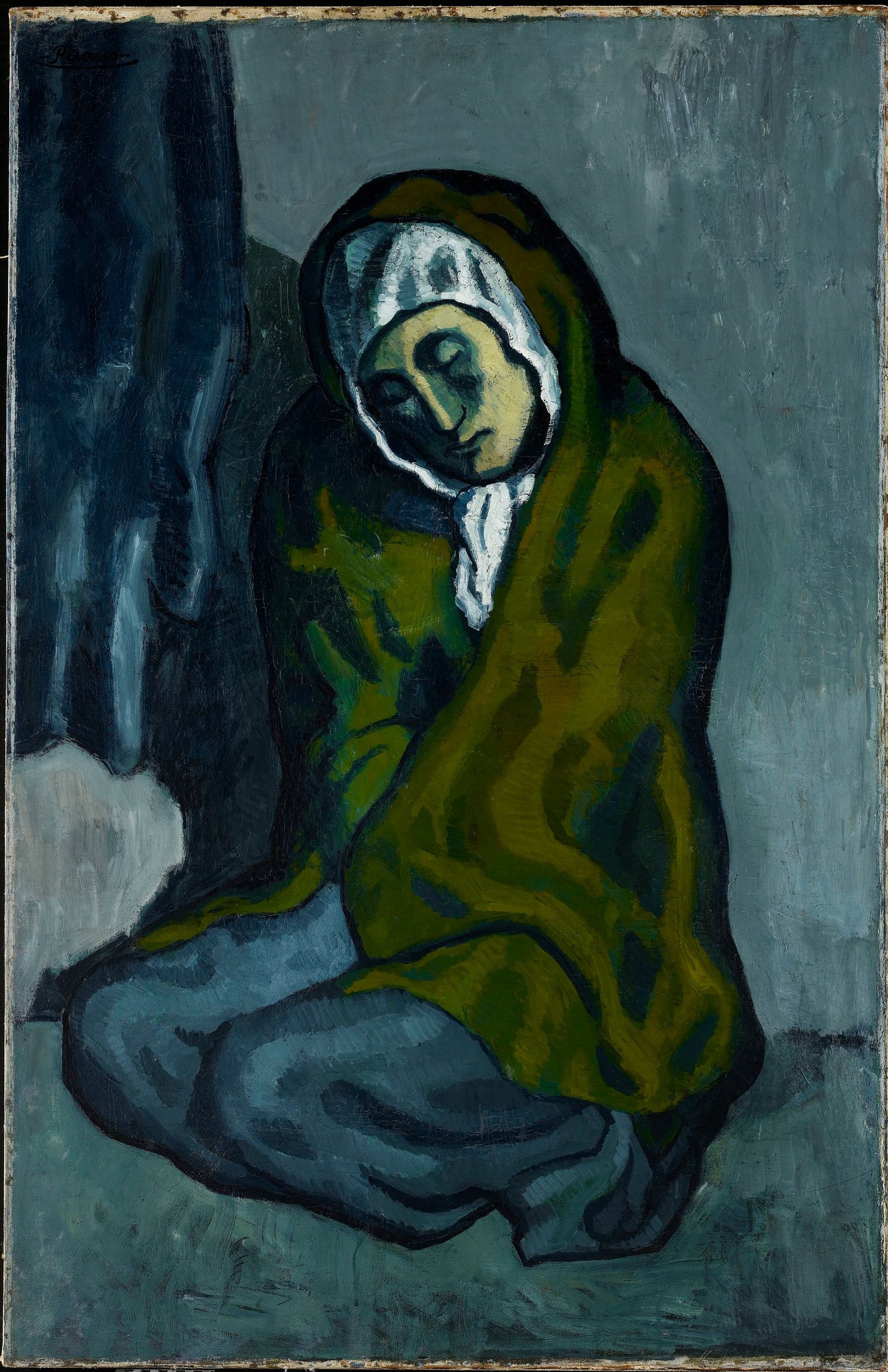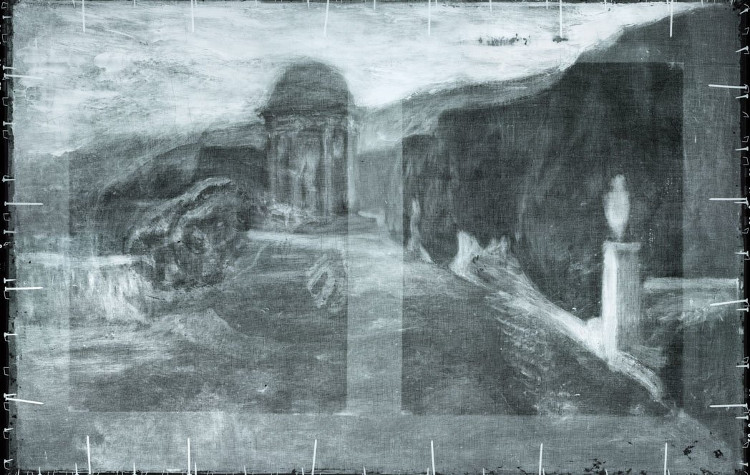Discover the secrets of Picasso's paintings
Scientists have discovered hidden secrets in Picasso's paintings and sculptures.
Chemistry and imaging science find 'pictures in pictures'

The painting 'La Miséreuse accroupie' (The Crouching Woman) by Pablo Picasso in 1902.
With specialized tools of medicine and geology, they 'looked' through the dark part of 'La Miséreuse accroupie' (The Crouching Woman) by Pablo Picasso in 1902 - 'Green stage' in the early morning his work. It is not too surprising. X-ray images have been shown to researchers, Picasso painted this painting on top of another landscape picture of himself.
The story begins with Sandra Webster-Cook, the conservation expert at the Art Gallery of Ontario (Ontario), which owns the painting, has observed the texture of brush strokes on the surface that seem to be do not reflect the details of the painting, nor reflect the context. 'There is definitely something below,' commented Webster-Cook.
Ontario staff invited experts at the National Gallery of Art, Northwestern University and the Chicago Art Research Institute to explore the issue.

The results of the x-ray showed below the image of a woman bowing her head, which is a hidden landscape.Picasso has rotated the plate 90 degrees, then overlaid it.
By using tools developed in the medical, geological, and industrial sectors, researchers have 'seen through' the plate without affecting it. They found that Picasso combined the edges of the hills from the landscape of the painting he had drawn earlier to form the curves behind the woman. 'It was like a repetition of jazz music both before and after,' explains Marc Walton, a professor of materials and engineering research at Northwestern University.
The analytical results discovered Picasso's repeated attempts to draw the woman's right arm. He eventually gave up on this idea and painted a cloak.
'Therefore, it is the study of the painting that enables us to thoroughly understand the artist's thinking and know more about his creative process , ' said Professor Walton.
The results of this study were presented at the meeting of the American Association for the Advancement of Science in Austin, Texas in the middle of February 2018. At this meeting, the researchers also presented new insights into Picasso's copper sculptures based on the analysis of alloy materials.
'We are opening a new era of investigating how iconic artworks have been created,' said Francesca Casadio, executive director of the science and conservation committee at the Institute. Artistic rescue Chicago.
Dr. Casadio and GS. Walton is the director of the Center for Artistic Scientific Research, a collaboration between Northwestern University and Chicago Art Institute to apply new technologies in art history studies.
Three years ago, Webster-Cook and Kenneth Brummel - curator of modern art of the Ontario Museum, attended a seminar in Barcelona on scientific analyzes of Picasso's Green paintings. . One of the scientists that Webster-Cook was there was John K. Delaney, visual scientist at the US National Gallery in Washington.
Dr. Delaney then went to Ontario to test 'La Miséreuse accroupie' with a technique of recording the brightness of light reflected through a visible spectrum of spectrum and the infrared spectrum of light.

Ultra-spectral imaging techniques have discovered a woman's right arm in a woman's cloak drawing.
Different molecules adsorb certain colors of light. The reflectance hyperspectral imaging technique allows researchers to identify minerals from specimens on dark bands of the spectrum. This is also the type of technology that NASA's Mars Reconnaissance Orbiter used to describe the composition of Martian stones.
Photos of TS. Delaney had clearly shown the woman's right arm that was hidden.
Scientists from the Center for Scientific Research in the Arts observed the picture and used a portable device to 'embed' the picture into X-rays, one of the ways to discover elements. used in color palette for painting. Different elements in the palette will be displayed on different wavelengths.
The display of steel and chromium in the painting - Prussian blue is a pigment synthesized on iron and chromium used in yellow pigments - perfectly matched to the structure of the painting " La Miséuseuse accroupie " . But the specimens also showed cadmium, the synthetic element, so the yellow, orange, red and white colors all showed a different drawing below, which provided more details about the arm and the table. Right hand under cloak.

The distribution of chemical elements in different color layers.
Mr. Brummel commented, "This arm represents a very strange position. The elbow is placed on the thigh, the forearm is drawn awkwardly just below the right shoulder and holding a plate ' (appears to be a loaf of bread) He also added that this "secret" arm seems to resemble the way of drawing a woman's arm that appears in a watercolor painting painted by Picasso in 1902.
Mr. Brummel focused his research on identifying the original landscape of the artist, thereby identifying the scene in which this artist is the Labyrinth Park of Horta labyrinth garden in Barcelona. According to him, no new findings can be made without the scanning method.
"Scientific equipment and collaboration between chemists and imaging scientists are contributing to the work of painting history , " said Brummel.
X-ray and seismic techniques reveal more mysteries
Scientists at Northwestern University and Chicago Art Research Institute used X-ray techniques to test Picasso's 39 bronze sculptures composed between 1905 and 1959, and 11 needle sculptures. type from 1960 in the Picasso museum in Paris.

Researchers found Picasso's composition of copper alloy in Picasso's "Head of a Woman, in Profile" sculpture in 1941 at Émile Robecchi foundry in Paris.
Dr. Casadio said: "The tools used in this test are the same, only the problems [need to be appraised from the works] are different".
Over the past decade, researchers have analyzed about 350 bronze sculptures made by many artists in Paris from the late 1800s to the mid-20th century. The composition of copper alloys provides geographic clues. Point and time the sculpture was created.
For example, the researchers were able to describe Émile Robecchi foundry in Paris, where 5 Picasso sculptures were created during the Second World War - the artist's bronze phase, the period still short…
The composition of the alloy used by Robecchi foundry in 1941 to 1942 is remarkably diverse - the highest of several stages is tin, another stage is zinc - it also reflects a reasonable lack of metal during the war.
Dr. Casadio said: "At the same time in Paris, the Germans secretly forced the French to melt the bronze statues in the city for metal."
With the late metal-covered statue "Head of a Woman" , researchers discovered Picasso used silver for hair, eyes and facial contours, a somewhat confusing option because he later use coating on this precious metal.
Dr. Casadio said: "We have measured 25 more times just to determine that it is 100% correct."
Other scientists are currently developing other new ways of scanning artwork. In a new paper published in November 2017 in Scientific Reports, researchers at the Georgia Institute of Technology described how they used a radar wave to study a 17th-century painting.
With a commercialized terahertz scanning technique - the industry used to detect cracks in plastic materials, researchers examined 'Madonna in Preghiera' by Italian artist Giovanni Battista Salvi.
Terahertz waves - a type of light with a wavelength longer than infrared but shorter than the ultrasound, passes through colors but jumps between the boundaries between different layers of paint.
Until now, terahertz waves were still rarely used in the study of paintings by wavelengths too large to study thin coatings."All of their scattering is on top of each other," said David S. Citrin, professor of electrical and computer engineering at the Georgia Institute of Technology.
Basically, people cannot measure things smaller than the ones that people are using. But in this application, GS. Citrin and colleagues discovered scattering dances into thin coatings. Advanced marking techniques in oil field surveys developed by the oil industry allowed them to score layers of about 20 microns in thickness - meaning less than 1/1000 of an inch (2.54 cm in each inch). .
Their technique could help painting history researchers study the classes of paintings in the way seismologists study the structure of rock components under the surface of the earth.
GS. Northwestern University's Walton said he wanted to go back to studying the 'La Miséreuse accroupie ' painting with a terahertz scanner.
Using a wide spectrum of scans will provide a more complete amount of information about the painting.'This is really a' holy grail 'that will work with every study of the painting. By combining the techniques together, we are starting to get a better understanding of the drawn structure toand '.
- Message mystery is hidden in famous ancient paintings
- Top 5 German Nazi secrets have been discovered
- The true meaning of world famous paintings that most of us do not know
- Discover priceless mosaic paintings from the 4th century
- Discover ancient mosaics mosaic 2,400 years with a surprising message
- The ghost picture haunts thousands of people
- Why do the characters in the painting always follow our eyes?
- The hundred-year-old painting was suddenly found in Antarctica
- 3D paintings like trying to get out of paper
- Discover secrets from tombs
- Not only artistic value, these 6 paintings also reveal incredible facts about the old world
- Find the lost picture of Delacroix
 'Fine laughs' - Scary and painful torture in ancient times
'Fine laughs' - Scary and painful torture in ancient times The sequence of numbers 142857 of the Egyptian pyramids is known as the strangest number in the world - Why?
The sequence of numbers 142857 of the Egyptian pyramids is known as the strangest number in the world - Why? History of the iron
History of the iron What is alum?
What is alum?